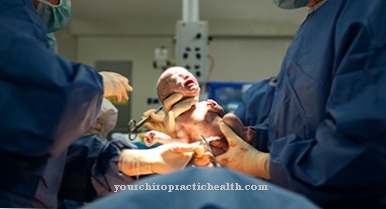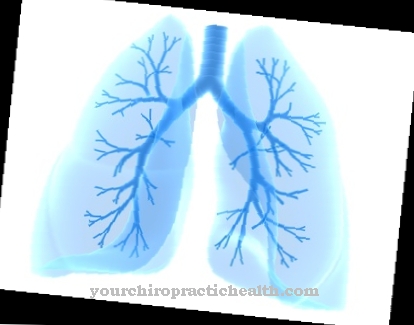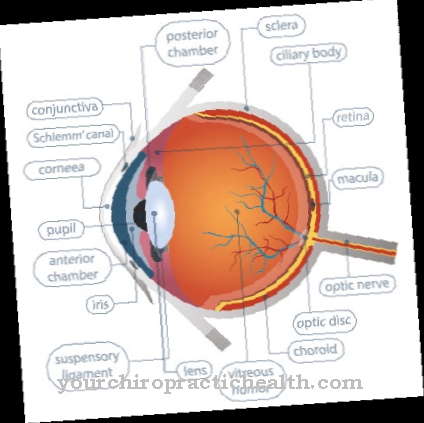The Pyoderma gangrenosum is characterized by the formation of ulcers on the skin and the formation of skin necrosis. Usually it is not a disorder in its own right, but rather a symptom of another underlying disorder. In severe cases, entire sections of skin tissue die.
What is pyoderma gangrenosum?

© Copyright - stock.adobe.com
A Pyoderma gangrenosum is characterized by ulcer formation and the death of entire areas of skin. The ulcer is called an ulcer and the extensive death of the skin is called gangrene. Pyoderma gangrenosum is not an infection, but an autoimmune disease in which the skin is attacked by its own immune system. The white blood cells are activated.
Only immunosuppressants such as glucocorticoids, cyclosporine A or dapsone can sufficiently weaken the immune system and contribute to remission of the symptoms.Pyoderma gangrenosum often occurs as part of another underlying disease such as ulcerative colitis, Krohn's disease, rheumatoid arthritis, vasculitis, chronic hepatitis or even leukemia.
However, it can also develop from the surgical wound after skin injuries or operations. The exact mechanism of its formation is not yet known. The ulcerations usually develop very slowly. However, there are also cases that come with massive outbreaks.
causes
Pyoderma gangrenosum is an autoimmune disease, the cause of which is not yet fully understood. It is also often seen as a complication of an existing autoimmune disease. This is also shown by the associations of pyoderma gangrenosum with other autoimmune diseases.
Around ten percent of all patients with pyoderma gangrenosum suffer from ulcerative colitis or Krohn's disease. Up to 50 percent of all cases are associated with rheumatoid arthritis, vasculitis, chronic arthritis, or leukemia. A causal relationship with the metabolic syndrome is also suspected. Overall, it is assumed that pyoderma gangrenosum is not an isolated skin disease, but is an expression of a skin reaction in a generalized systemic disease process on an autoimmune basis.
Symptoms, ailments & signs
Pyoderma gangrenosum often begins with the formation of pustules and papules on the skin, which quickly enlarge and grow together. Eventually they later decay and form a painful ulcer. There is a central zone of necrosis in the middle of the ulcer. A bluish-livid discoloration appears at the border area to the intact skin. No infections are found in the ulcer.
In most cases, the disease develops very slowly. However, there are also cases with rapid development that sometimes even require amputation of the affected limb. The lower legs are 80 percent affected. However, all other areas of the skin can also be affected by pyoderma gangrenosum.
If the affected areas are infected, severe disease courses are to be expected. Other symptoms are very common. Depending on the underlying disease, severe digestive problems, rheumatic symptoms, or chronic respiratory problems are common.
Diagnosis & course of disease
For the most part, the diagnosis of pyoderma gangrenosum is based on the typical clinical features of the disease. Vasculitis (inflammation of the blood vessels) is also common in the early stages of the disease. Therefore, a trial excision in the diseased area is also useful at this stage. Later only inflammatory reactions can be detected.
No concrete changes can be detected serologically. Sometimes there is evidence of pathologically elevated concentrations of monoclonal antibodies or variable autoantibodies. As part of a differential diagnosis, specific skin diseases such as erythema, skin tuberculosis, Buruli ulcer, erysipelas, leg ulcers or syphilis must be excluded.
Complications
With this disease, patients suffer from a number of unpleasant skin conditions. This primarily leads to skin necrosis and also to the formation of ulcers under the skin. For this reason, those affected also depend on regular examinations in order to avoid various complications. The further course of the disease depends very much on the exact cause, so that a general prediction of the complications is usually not possible.
In the worst case, however, the skin layers can die off. Pustules and papules develop on the skin itself. The ulcers are usually painful and the skin may take on an unnatural color. In some cases, if the disease is not treated, the affected limb may need to be amputated.
The disease can be treated with the help of medication. However, the main focus is on treating the underlying disease. As a rule, those affected are also dependent on psychological treatment. Life expectancy is not negatively affected by successful treatment. However, based on the treatment, it cannot be ruled out that the symptoms will not recur in the patient's life.
Therapy & Treatment
For the treatment of pyoderma gangrenosum, non-adhesive wound dressings and wound dressings are used, which promote the formation of granulation tissue. Furthermore, wound healing is accelerated by regular scraping (curettage) on the affected areas. However, surgical removal of necrosis is contraindicated because it can enlarge the lesions.
This effect is also known as the pathergy phenomenon. Overall, good results are achieved with the systemic use of immunosuppressants. The main immunosuppressants used are high-dose glucocorticoids in combination with cytostatics such as azathioprine or cyclophosphamide. Therapy with glucocorticoids alone often leads to a relapse after its discontinuation. Therefore, better results occur when various processes leading to immunosuppression are combined.
Bacterial colonization of the wounds can be prevented by poultices with Rivanol and, in the case of mild forms, by baths with table salt and chlorhexidine. The patient's movement should not be restricted during treatment, as regular walks encourage lymph flow. This means that any swellings that occur can be reduced. An accompanying pain treatment is provided by the administration of analgesics.
An important component of the therapy is the psychological treatment. Especially with such extreme illnesses as pyoderma gangrenosum, psychological side effects are to be expected. Methods such as autogenic training, progressive muscle relaxation or individual deep relaxation help to reduce stress. Psychotherapeutic treatment is also recommended.
You can find your medication here
➔ Medicines against redness and eczemaprevention
Since the exact cause of pyoderma gangrenosum is not known, there are no specific recommendations for its prevention. Existing autoimmune diseases make the disease more likely to experience symptoms. Continuing treatment of the underlying condition may also lower the risk of pyoderma gangrenosum.
General recommendations for a healthy lifestyle with a balanced diet, plenty of exercise and avoiding alcohol and cigarettes are always good for the well-being of the body. In individual cases, they may also help reduce the risk of pyoderma gangrenosum.
Aftercare
In most cases, sufferers of pyoderma gangrenosum have only a few measures and options for direct follow-up care. For this reason, a doctor should be consulted at an early stage in order to prevent further complications or complaints from this disease. Self-healing cannot occur, so a doctor should be contacted at the first signs or symptoms.
Many of those affected are dependent on taking various medications. It is always important to ensure that it is taken regularly and that the dosage is correct in order to counteract the symptoms correctly and permanently. Furthermore, those affected should also wear compression stockings in order to completely heal the pyoderma gangrenosum. If you have any questions, or if you have any side effects, you should always consult a doctor first.
Many of those affected are also dependent on psychological help during treatment, whereby the support of their own family can have a very positive effect on the further course of the disease. The further course of pyoderma gangrenosum is, however, strongly dependent on the time of diagnosis and also on the severity of the disease, so that a general prediction is not possible.


.jpg)
























